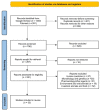Fosfomycin Resistance in Bacteria Isolated from Companion Animals (Dogs and Cats)
- PMID: 37235420
- PMCID: PMC10223593
- DOI: 10.3390/vetsci10050337
Fosfomycin Resistance in Bacteria Isolated from Companion Animals (Dogs and Cats)
Abstract
Fosfomycin is an old antibacterial agent, which is currently used mainly in human medicine, in uncomplicated Urinary Tract Infections (UTIs). The purpose of this review is to investigate the presence and the characteristics of Fosfomycin resistance in bacteria isolated from canine or feline samples, estimate the possible causes of the dissemination of associated strains in pets, and underline the requirements of prospective relevant studies. Preferred Reporting Items for Systematic Reviews (PRISMA) guidelines were used for the search of current literature in two databases. A total of 33 articles were finally included in the review. Relevant data were tracked down, assembled, and compared. Referring to the geographical distribution, Northeast Asia was the main area of origin of the studies. E. coli was the predominant species detected, followed by other Enterobacteriaceae, Staphylococci, and Pseudomonas spp. FosA and fosA3 were the more frequently encountered Antimicrobial Resistance Genes (ARGs) in the related Gram-negative isolates, while fosB was regularly encountered in Gram-positive ones. The majority of the strains were multidrug-resistant (MDR) and co-carried resistance genes against several classes of antibiotics and especially β-Lactams, such as blaCTX-M and mecA. These results demonstrate the fact that the cause of the spreading of Fosfomycin-resistant bacteria among pets could be the extended use of other antibacterial agents, that promote the prevalence of MDR, epidemic strains among an animal population. Through the circulation of these strains into a community, a public health issue could arise. Further research is essential though, for the comprehensive consideration of the issue, as the current data are limited.
Keywords: ARGs; Fosfomycin resistance; PRISMA guidelines; cat; companion animals; dog; pets.
Conflict of interest statement
The authors declare no conflict of interest.
Figures


References
Publication types
LinkOut - more resources
Full Text Sources
Miscellaneous

